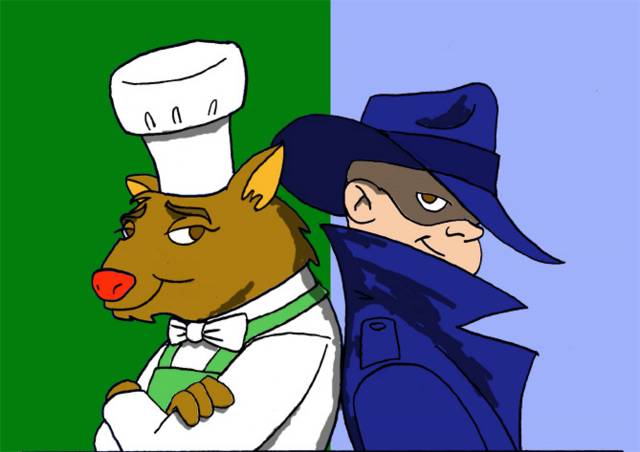Not Quite the Great Escape, or, Bad Journalism at the CBC
Actually, the context is closer to the old Sherlock Holmes story "The Red-Headed League," but even though the circumstances are criminal I can't help but hear the Elmer Bernstein theme music upon reading this story:
SEATTLE (CP) - U.S. government agents have shut down a drug-smuggling tunnel built under the Canadian border between Aldergrove, B.C., and Lynden, Wash.
The exact length of the tunnel was not known. It ran from a building on the Canadian side to a house on the U.S. side, 90 metres from the border.
The Seattle Times' website reported that investigators used a machine that can "see" underground, a video-equipped robot, a drug-sniffing dog and an air horn to find it.
Neighbours said they had suspicions about the building but were shocked to discover what is alleged to have been going on inside.
A woman who lives near the tunnel on the American side of the border said federal agents stopped her when she tried to drive home Wednesday. She said three people were arrested in the abandoned home; Border Patrol agents confirmed the arrests.
"It blows me away," Ruthie Steinfort told the Times. "We're right next to the border station."
It is not clear if Canadian police knew of the U.S. investigation.
Y'know, if one were a lefty blogger, one couldn't help but remark that he didn't think disaffected Tories were that desperate to leave the country for Bushworld ...
UPDATE (10h40 EDT): Well, the CBC has an update on the story, and from here it's a perfect example of how the CBC never lets the truth get in the way of a good story.
For example, the CP story lists the Canadian terminus for the tunnel as Aldergrove, while the CBC story says it's Langley. (The Seattle Times story doesn't list the Canadian terminus.) Since, according to MapQuest, Aldergrove is closer to Linden, WA than Langley, I'm inclined to give the edge to CP.
Next, we have this paragraph:
Sources told the The Seattle Times newspaper the tunnel had a concrete floor, fibreglass walls, ventilation, video security and a groundwater-removal system.
It apparently had been under construction for eight months, and the FBI and drug enforcement agents had been monitoring its progress.
Interesting detail. Just one problem: the Seattle Times story used that description for a different tunnel, on the U.S./Mexico border:
In March, U.S. officials found a tunnel that had been dug from a middle-class San Diego-area neighborhood to an upscale residence in Mexico. Investigators called the 200-yard-long tunnel the most sophisticated they have seen along the California-Mexico border.
Investigators used a machine that can "see" underground, a video-equipped robot, a drug-sniffing dog and an air horn to find it.
That tunnel was 3 feet wide and 5 feet high with a concrete floor. It had wood-beam supports, fiberglass walls, ventilation, video security and groundwater-removal systems. Several altars with flowers and pictures of saints also were found inside.
How did the Times story describe the Linden tunnel?
A law-enforcement source familiar with the investigation said it was newly constructed and designed for drug trafficking.
He said the tunnel passed under two roads and appeared to be skillfully built.
"It wasn't built by a teenager with scrap wood from nearby homes," said the source, speaking on condition of anonymity.
The law-enforcement source said a portion of the tunnel's interior was lined with wood. He called the underground project "elaborate." He said that when he traveled to the site about a month ago, it was still under construction, but added it could have been completed by now.
Not very sexy, right? And the information comes from an anonymous source, which are always suspect nowadays. No wonder the CBC flack opted to go with a more sexy description, even though it was misleading. (Although, to be fair, the CP story made the same error.)
Possibly the most misleading part of the CBC story comes from the map supplied, intended to show the tunnel:

Fine and dandy, except that the tunnel's total length was reported to be 100 yards --the length that could fit in a football stadium, not the distance between the two towns. This is a very misleading graphic.
Moral of the story? Journalists can still get the details wrong -- even those at the CBC.
And they wonder why the public has no confidence in them?
UPDATE 2 (14h55 EDT): The CBC has an updated story up, correcting the location and giving more details about the tunnel:
Police say the 1.5-metre high, one-metre wide tunnel runs from a metal Quonset hut just north of the border to an abandoned house in Lynden, Wash. -– just 90 metres south of the border.
Francis Devandra Raj, 30, Timothy Woo, 34, and Jonathan Valenzuela, 27, face charges in the U.S. of conspiracy to distribute marijuana and conspiracy to import marijuana.
Police say they believe it's the first tunnel they've ever found crossing the Canadian border. They say the tunnel is sophisticated, with a concrete floor, iron reinforcements and wood supports.
It had been under construction for eight months, and was first spotted by Canadian border officials back in February.
The updated story doesn't use the faulty map; however the earlier story link is still active as of this writing (though I don't think it'll stay that way for long).





<< Home